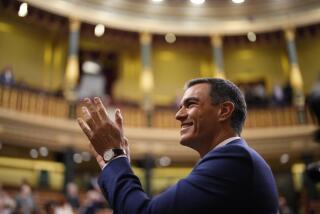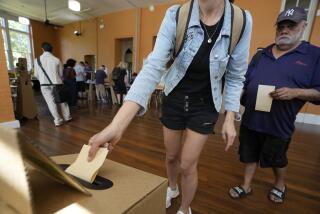Australian Premier Wins Reelection
- Share via
SYDNEY, Australia — Overcoming resistance to a controversial tax reform plan, the conservative coalition government headed by Prime Minister John Howard won reelection by a narrow margin Saturday, according to incomplete reports on Australian federal elections.
But Howard, who won by a landslide here in 1996, saw his Liberal Party-National Party coalition fall from an overwhelming majority to a slim majority in the Australian House of Representatives, casting doubt that he will be able to push through a proposed national 10% tax on goods and services, accompanied by cuts in personal and corporate income taxes.
“It is clear that the coalition will have a working majority in the new Parliament,” Howard announced to cheering supporters at Sydney’s Wentworth Hotel. He continued to defend his tax package, calling it a “bold economic reform that is in the long-term interest of the Australian community.”
The Australian Broadcasting Corp. projected the Liberal-National coalition would emerge with a six-seat majority in the 148-member lower house. The coalition was expected to fare less well in the Senate, where 40 of the upper body’s 76 seats were being contested and where the coalition already is a minority.
The opposition Labor Party, meanwhile, rebounded from its humiliating 1996 defeat to gain a projected 20 seats in the lower house.
“The Labor Party is back in town,” party leader Kim Beazley said in a brief concession statement. “We approach the next three years with great confidence.”
In its first national campaign, the populist, right-wing One Nation Party suffered a blow when its charismatic leader, Pauline Hanson, a former fish-and-chips-shop owner from Queensland, narrowly lost her race for reelection.
However, the One Nation Party, which has attracted attention across Asia with its protectionist, anti-immigrant stance, won nearly 10% of the national vote and was in a position to win Senate seats in Queensland and New South Wales.
“One Nation will go on,” Hanson said in an interview with the Australian Broadcasting Corp. “Opinion polls predicted we would win only 7% to 8% of the vote, but in a lot of seats we are actually polling 20%.”
Hanson, who once claimed in a speech before Parliament that Australia was being “swamped” by Asian immigrants, lost her race in the rural Blair district near Brisbane.
She can return to Parliament as a member of the Senate if one of the winning One Nation candidates steps aside in her favor.
In his victory speech, Howard indirectly attacked racist sentiments espoused by some supporters of the One Nation movement.
“We are a nation of many parts and many origins,” Howard said, “and we should not forget that.”
As the One Nation movement grew here, capturing nearly 25% of the vote in Queensland state elections this summer, Howard was criticized by several Asian leaders, including senior Singaporean statesman Lee Kuan Yew, for not speaking out forcefully enough against Hanson and her party.
National Party leader Timothy Fischer, who serves as deputy prime minister in the coalition government, celebrated the election as a defeat of the One Nation movement, which is particularly strong in rural areas where his party is strongest.
“What is clear tonight,” Fischer said, “is that the anti-trade, racist element of One Nation has been rejected by the people of Australia.”
However, because of Australia’s complicated preferential voting system, it appeared that One Nation voters probably helped the coalition maintain its slim majority by naming the Liberal or National party as their second choice on ballots.
Under the Australian voting procedure, if no candidate wins an outright majority, second preferences are taken into consideration in determining a winner.
More to Read
Sign up for Essential California
The most important California stories and recommendations in your inbox every morning.
You may occasionally receive promotional content from the Los Angeles Times.













